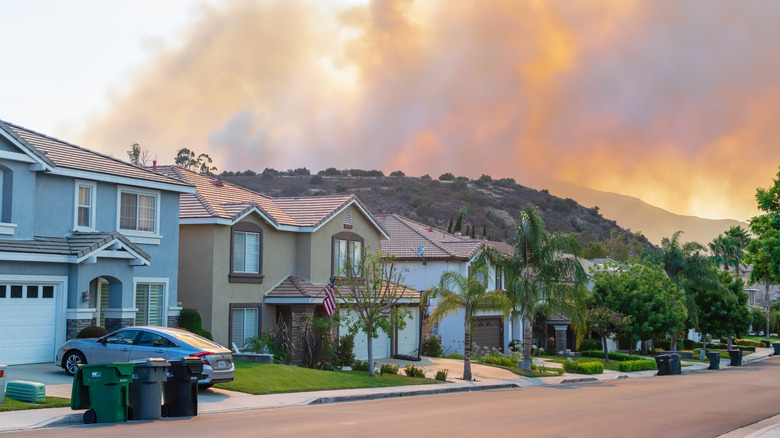Everything To Know About Homeowners Insurance In The Case Of Wildfire Damage
The smell of wood smoke can rouse you from a deep sleep if you live in a fire-prone region. The threat of losing property to wildfires is a reality for many homeowners. With climate change making itself evident in growing ways, winds and drought are escalating the risks of flames encroaching on your home. If the worst happens and your home suffers damage or is lost, we hope the insurance we've been paying will step up and cover costs. But will it?
According to the Insurance Information Institute, standard homeowner's insurance will cover property damage and loss from wildfires. This includes outbuildings, vehicles, belongings inside your home, and smoke damage remediation. As well, they state that if you need housing during repair work or rebuilding, insurance should cover additional housing costs. Yet, some insurance companies such as Allstate and Progressive state that homeowner's policies may help cover losses, but this language leaves a lot of uncertainty. To get a clearer picture, we exclusively interviewed Ken Maddis, an Independent Agent at Affordable American Insurance and Safeco Insurance, who stated, "The language in insurance policies always includes a bit of hedging."
What can you do to rest easy?
It's easy to make mistakes when buying home insurance, and you might not know what exactly it will cover in case of an emergency. When in doubt, find out! During our exclusive interview with Ken Maddis, when asked what homeowners can do to find out what will be covered in case of wildfire damage, he advises talking directly to your agents. "You can't really know exactly what will be covered until you make a claim," Maddis cautioned. However, with policies like HO-3 (the most common type of homeowners insurance) and better, he asserted that most wildfire damage should be covered.
We also asked Maddis if there were additional steps to insure property against wildfires. He mentioned that many policies include an endorsement for extended replacement costs. Maddis told us that this financial buffer is "25 to 50% would be what an insurance company can add toward the replacement of a home. For example, if someone is insured for $400,000 with 50% extended replacement coverage, then they would actually have up to $600,000 available toward the actual reconstruction costs."
Western states, especially Texas, Colorado, and California, are the most at-risk states for wildfire damage, and it can be a challenge to insure your property in these areas. If you are struggling to insure your property, see if your state offers Fair Access to Insurance Requirements (FAIR) plans; these programs help homeowners get insured in fire-prone areas. FAIR plans tend to be costly and more limited in what they'll cover, but they will help defray some costs.

